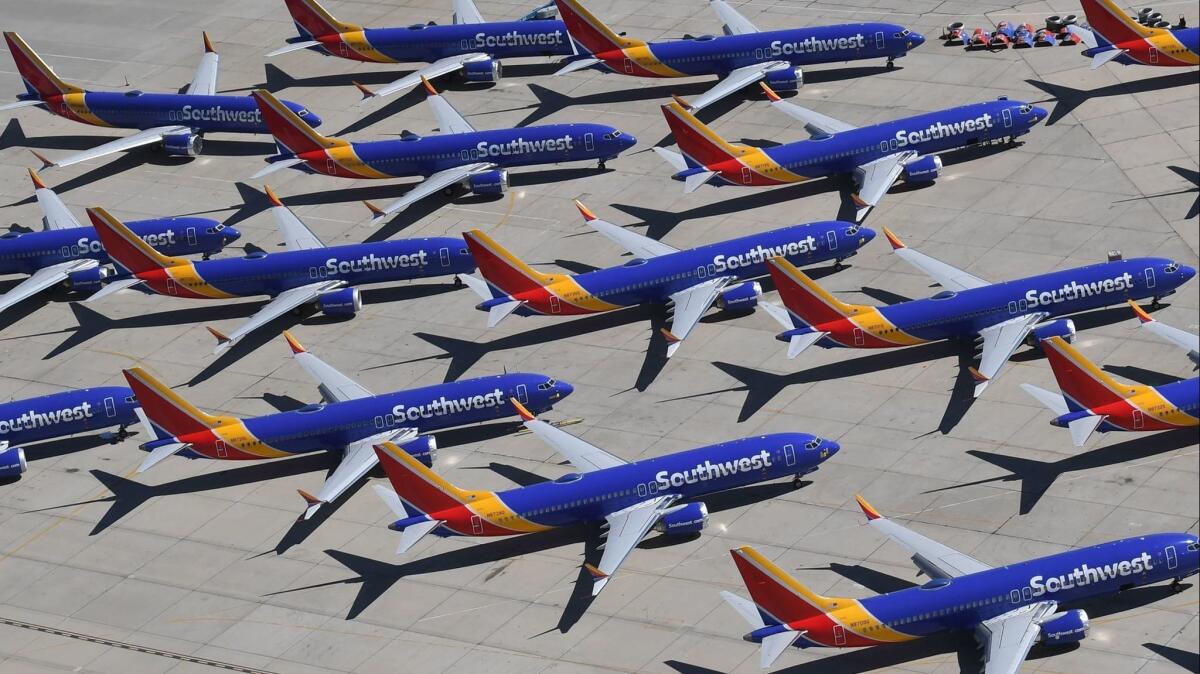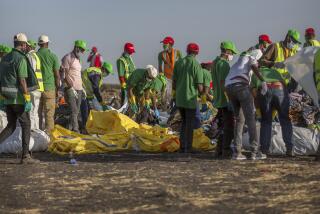EU agency is said to have skipped 737 Max meeting in snub to Boeing

- Share via
There was a prominent no-show among the 200 regulators, pilots and airline managers that Boeing Co. invited to preview a crucial software update for the 737 Max this week, said people familiar with the matter: European safety officials.
The plane maker is sending a team across the Atlantic to brief the European Union Aviation Safety Agency on the proposed changes after two of the jetliners plunged to the ground within a five-month period, said one of the people, who asked not to be identified because the discussions are private. Representatives of EASA didn’t return requests for comment.
Intentional or not, EASA’s snub points to the delicate politics Boeing faces in convincing regulators the Max is safe as the company seeks to restore confidence in its bestselling jet, which has been grounded for more than two weeks. The reputation of U.S. regulators has taken a hit in the scrutiny of the 737 Max’s approval process, and foreign agencies are less likely to rubber-stamp aircraft certifications simply because they have been cleared by the Federal Aviation Administration.
EASA is expected to play an influential role in determining how long and complicated the review of the Max will be, while safety officials from China to Canada have vowed to conduct their own rigorous analysis.
“EASA’s determination should be important for the rest of the world, given its sophistication and perceived independence,” said Seth Seifman, analyst with JPMorgan Chase & Co., in a note to clients.
A spokesman for the FAA declined to comment.
‘Productive’ sessions
“We had productive information sessions this week and continue to work closely with our customers and regulators on software and training updates for the 737 Max,” Boeing spokesman Paul Bergman said by email.
As of late Friday, the Chicago-based plane maker was still finishing up paperwork needed to certify a software upgrade and revised pilot training for the 737 Max. One prominent pilots union criticized the proposed training as insufficient.
The software changes, intended to prevent stall-prevention software from engaging in normal flight, have been in the works since the system pointed a Lion Air jet’s nose downward about two dozen times before pilots lost control Oct. 29. That accident killed 189 people; 157 died when an Ethiopian Airlines 737 Max 8 crashed March 10.
Though certifying the software upgrade is the first step toward returning the Max to flight, it doesn’t assure the grounding will be speedily lifted by the FAA or its counterparts around the world. The EU, China and Canada all grounded the 737 Max more quickly than the FAA in the wake of the Ethiopian crash.
Software changes
The break between FAA and overseas authorities on the initial decision to ground the plane, combined with worldwide public furor and a U.S. criminal probe of the Max certification, “all make it hard for us to see how foreign regulators can avoid coming back with their own questions and doing some of their own due diligence,” Seifman said in his report.
Crash investigators suspect that a damaged or malfunctioning sensor triggered anti-stall technology in the Ethiopian Airlines plane, Bloomberg reported Friday. Investigators think that caused the plane’s nose to point downward, and the pilots struggled to counteract the software-based system, according to people familiar with the crash probe. That scenario would be similar to the crash that brought down the Lion Air flight last year in Indonesia.
Boeing is planning software revisions that restrict the number of times the Maneuvering Characteristics Augmentation System, or MCAS, kicks in to a single interaction. The update is also designed so that MCAS can’t command the horizontal stabilizer to push a plane’s nose down with more force than what pilots can counter by pulling back on the steering column.
The enhancements appeared to work as billed, said pilots who viewed demonstrations of the upgrades by company test pilots in flight simulators at the event Wednesday in Renton, Wash.
“We were confident flying the aircraft in its present state,” said Roddy Guthrie, American Airlines Group Inc.’s 737 fleet captain, who was at the Boeing briefings. The improvements “were needed. They’ve put some checks and balances in the system now that will make the system much better.”
Simulator demonstrations
Still, Boeing representatives faced caustic comments from some at the Wednesday session, said one of the people familiar with the discussions. As Boeing test pilots demonstrated old and new versions of MCAS, attendees were especially interested in re-enacting the sequence of events leading to the Lion Air crash, the person said. Pilots also demonstrated how the 737 Max would behave if an angle-of-attack vane was sheared off by, say, a bird strike.
One pilot group walked away from the event feeling that Boeing needs to do more work on a new 30-minute iPad course, followed by a test, that is intended to help pilots of the older generation of 737 planes prepare for the Max. The newest version of Boeing’s workhorse single-aisle jet debuted less than two years ago.
Pilots who saw the preliminary version of the training “characterized it as nice for an elementary level of understanding, but pilots will definitely need a more textured and layered instructional piece,” said Dennis Tajer, spokesman for the Allied Pilots Assn., which represents pilots at American. “That was the hands-down consensus.”
Boeing was receptive to the comments, Tajer said.
More to Read
Inside the business of entertainment
The Wide Shot brings you news, analysis and insights on everything from streaming wars to production — and what it all means for the future.
You may occasionally receive promotional content from the Los Angeles Times.










